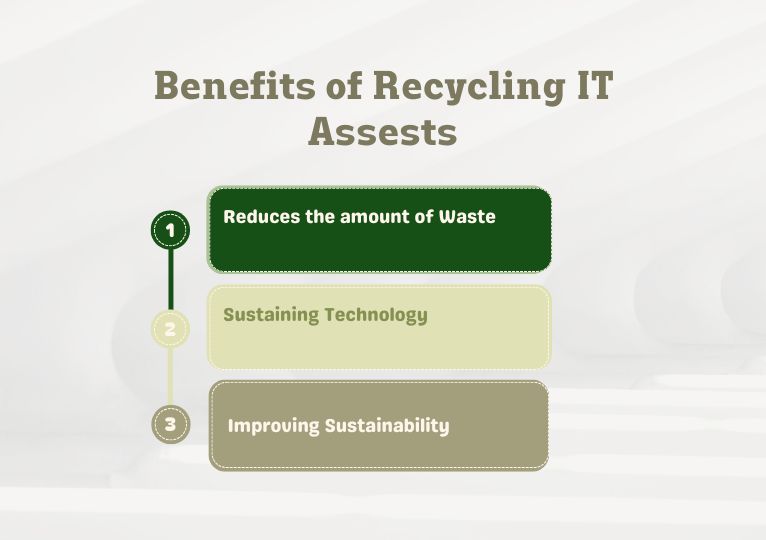Recycling IT Assets: Why It Matters and How to Do It Right
Recycling IT assets can help in reducing IT waste, extend the usability of technology, and support sustainability for a long time. Many organizations replace their IT equipment regularly, which leads to significant amounts of electronic waste. But when you do proper recycling, it ensures these assets don’t end up in landfills but are reused, repurposed, or disposed of responsibly.
It may surprise you to learn that the India IT Asset Disposition Market, which includes secure data destruction, de-manufacturing, recycling, and remarketing of IT assets, was valued at approximately USD 318.37 million in 2023. And it is expected to grow to about USD 636.03 million by 2032, with a Compound Annual Growth Rate (CAGR) of 8.42%. This highlights the importance of recycling IT assets responsibly.
Table of Contents
- Process of Recycling IT Assets
- Benefits of Recycling IT Assets
- FAQs on Recycling IT Assets
Process of Recycling IT Assets
This is the most common question that arises when someone is asked about recycling. IT asset recycling solutions involve several key steps to ensure that sensitive data is handled properly and that materials are disposed of in an eco-friendly manner.
1. Preparing the Items for Recycling
Before recycling, it is essential for you to evaluate each asset, check its condition, functionality, and data security needs, and see if it can be refurbished, resold, or sent for disposal.
2. Cleaning and Data Conversion
Data conversion and cleaning are critical steps in the process of IT asset recycling solutions. Before recycling, it is necessary for you to back up important data and use secure data erasure software like BitRaser to remove confidential files. For highly sensitive data, physical destruction of storage devices may be the best option for you. Compliance with data protection regulations should also be ensured.
3. Asset Disposition
Asset disposition is another important stage. It involves determining whether the asset can be reused or resold. You may partner with IT asset disposition (ITAD) companies like USH India and others to ensure secure recycling. You can salvage some components for repairs or upgrades, while non-functional devices can be sent to certified recyclers to handle disposal safely.
4. Choosing the Right Time to Recycle
Recycling IT assets at the right time is essential. Replacing outdated IT assets before they become completely unusable will provide you with better recycling opportunities. Selling or donating working equipment instead of storing unused items will prevent you from keeping unnecessary waste. Scheduling regular IT asset reviews can also help you to manage the electronic waste effectively.
5. Using the Latest Technology
Using the latest technology can also contribute to responsible IT asset recycling. Newer IT equipment is often designed with recyclability in mind, and many manufacturers offer take-back programs for old devices. Choosing modular designs makes upgrading easier and reduces electronic waste. Purchasing from environmentally responsible brands supports sustainable practices.
6. Contacting Local Recyclers
Contacting local recycling centers is a crucial step in ensuring that IT assets are disposed of correctly. Many cities have designated e-waste recycling centers that accept IT assets and follow proper disposal methods for computer recycling. Some retailers and manufacturers also offer drop-off programs for used electronics. Certified recyclers ensure that hazardous materials are handled safely and responsibly.
Benefits of Recycling IT Assets
There are several benefits of IT recycling:
1. Reduces the Amount of Waste
Computers, printers, and servers contain hazardous materials that, if not disposed of correctly, can release harmful substances into the environment and can result in increasing pollution. By recycling, you can ensure that valuable components are being recovered and repurposed, minimizing landfill waste and reducing pollution caused by electronic scrap.
2. Sustaining Technology
Many IT assets still have functional parts that can be refurbished. Components such as hard drives, memory, and processors can be reused, helping companies and individuals save money by purchasing refurbished devices. Extending the life of IT equipment also reduces the demand for new manufacturing, which helps conserve resources and decrease environmental impact.
3. Improving Sustainability
Recycling IT assets helps you to conserve resources like metals and plastics while lowering energy consumption by reducing the need for raw material extraction. Organizations that recycle responsibly also demonstrate their commitment to sustainable practices, which can enhance their reputation and credibility.

FAQs
1. What is IT asset recycling?
IT asset recycling refers to the process of safely disposing of outdated or unused electronic devices like computers, servers, and printers. It involves data erasure, refurbishment, or responsible disposal to reduce e-waste.
2. Why is data erasure necessary before recycling IT assets?
Before recycling IT assets, data must be erased to prevent unauthorized access. Secure deletion methods, such as BitRaser software or physical destruction help in secure e-waste management. It ensures that confidential information does not fall into the wrong hands.
3. How does IT asset disposition (ITAD) work in recycling IT assets?
IT asset disposition (ITAD) involves evaluating IT equipment, securely erasing data, refurbishing reusable components, and responsibly recycling unusable parts through certified recyclers like USH India.
4. When is the right time for recycling IT assets?
Recycling IT assets should be done before devices become completely obsolete. Regular IT audits help organizations decide whether to resell, donate, or recycle outdated equipment.
5. How can USH India assist in sustainable IT disposal?
USH India provides expert services in recycling IT assets including secure data destruction, certified e-waste recycling, and IT asset refurbishment. They ensure compliance with environmental and data security regulations while maximizing the reuse potential of IT assets.
Learn about e-waste recycling in Mumbai, e-waste recycling in Noida, and e-waste recycling in Hyderabad.
